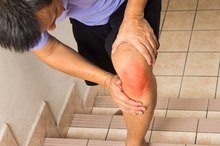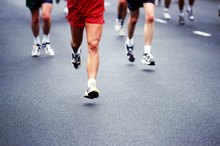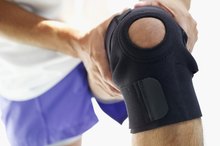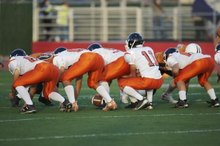What does fact checked mean?
At Healthfully, we strive to deliver objective content that is accurate and up-to-date. Our team periodically reviews articles in order to ensure content quality. The sources cited below consist of evidence from peer-reviewed journals, prominent medical organizations, academic associations, and government data.
The information contained on this site is for informational purposes only, and should not be used as a substitute for the advice of a professional health care provider. Please check with the appropriate physician regarding health questions and concerns. Although we strive to deliver accurate and up-to-date information, no guarantee to that effect is made.
Massage Techniques for a Damaged ACL
A damaged or torn anterior cruciate ligament is a very painful condition in which the ligament that connects the thigh bone to the shin bone of your lower leg tears and can no longer stabilize the kneecap. Medical attention is needed for an ACL injury, as well as physical therapy. One aspect of the physical rehabilitation is massage therapy.
How Massage Therapy Can Help
According to the Mayo Clinic, massage therapy techniques have the ability to reduce swelling, increase circulation and joint mobility, as well decrease pain 2. Massage therapy is generally considered safe by the medical community, and recognized as an effective complementary treatment for many chronic muscle and joint problems.
Palpitation Technique
Ligament Tear & Knee Hyperextension
Learn More
With your leg outstretched and parallel to the floor, place the middle and index finger of each hand on either side of the damaged knee approximately 1/2-inch down from your kneecap. Rub the area in a small, steady circular motion for 2 to 3 minutes at a time. This will help loosen the undamaged tendons and ligaments that are over-compensating for the injured ACL. This technique also reduces fluid retention in the knee area.
- With your leg outstretched and parallel to the floor, place the middle and index finger of each hand on either side of the damaged knee approximately 1/2-inch down from your kneecap.
- This will help loosen the undamaged tendons and ligaments that are over-compensating for the injured ACL.
Cross-Friction on the Patella Technique
This massage technique involves creating mild friction on the frontal ligaments of the knee. You will need another person to help with this technique. Sit comfortably on the floor or another flat surface. Slowly pull your injured knee up toward your chest while keeping your foot flat on the ground. Once your knee is bent in a natural position, the other person should place all four fingers of each hand on either side of your knee. Have him place both thumbs just under the front of your kneecap and apply moderate pressure. Begin moving the thumbs from side to side simultaneously for 1 minute.
- This massage technique involves creating mild friction on the frontal ligaments of the knee.
- Once your knee is bent in a natural position, the other person should place all four fingers of each hand on either side of your knee.
Roll Massage
How to Stretch the Foot Arch
Learn More
For this technique, you will need to be seated on a chair with your knees bent. Carefully lift the leg that has the injured knee and place your ankle on your good knee. Position the palms of your hands on each side of your knee, and gently wrap your fingers around the front of your knee, just above your shin. Begin sliding your fingers backward across the skin, and the forward again creating a rolling motion with your hands. Continue the exercise for 2 to 3 minutes.
- For this technique, you will need to be seated on a chair with your knees bent.
- Begin sliding your fingers backward across the skin, and the forward again creating a rolling motion with your hands.
Precautions
Knee injuries are delicate and susceptible to further damage if not treated properly. If you have suffered from a new injury of any sort, it's important to speak with a qualified health professional to come up with a proper course of treatment for your injury.
Related Articles
References
- MayClinic.org: Massage
- Sports Injury Clinic: Video: Sports Massage for the Knee
- Self-Massage for Athletes by Rich Poley: Knee Massage
- Lespasio MJ, Piuzzi NS, Husni ME, Muschler GF, Guarino A, Mont MA. Knee Osteoarthritis: A Primer. Perm J. 2017;21:16-183. doi:10.7812/TPP/16-183
- Kiapour AM, Murray MM. Basic science of anterior cruciate ligament injury and repair. Bone Joint Res. 2014;3(2):20-31. doi:10.1302/2046-3758.32.2000241
- Doral MN, Bilge O, Huri G, Turhan E, Verdonk R. Modern treatment of meniscal tears. EFORT Open Rev. 2018;3(5):260-268. doi:10.1302/2058-5241.3.170067
- Reinking MF. CURRENT CONCEPTS IN THE TREATMENT OF PATELLAR TENDINOPATHY. Int J Sports Phys Ther. 2016;11(6):854-866.
- Petersen W, Rembitzki I, Liebau C. Patellofemoral pain in athletes. Open Access J Sports Med. 2017;8:143-154. doi:10.2147/OAJSM.S133406
- Frush TJ, Noyes FR. Baker's Cyst: Diagnostic and Surgical Considerations. Sports Health. 2015;7(4):359-65. doi:10.1177/1941738113520130
- Huang YC, Yeh WL. Endoscopic treatment of prepatellar bursitis. Int Orthop. 2011;35(3):355-8. doi:10.1007/s00264-010-1033-5
- Beals C, Flanigan D. A Review of Treatments for Iliotibial Band Syndrome in the Athletic Population. J Sports Med (Hindawi Publ Corp). 2013;2013:367169. doi:10.1155/2013/367169
- Tsai CH, Hsu CJ, Hung CH, Hsu HC. Primary traumatic patellar dislocation. J Orthop Surg Res. 2012;7:21. doi:10.1186/1749-799X-7-21
- Ragab G, Elshahaly M, Bardin T. Gout: An old disease in new perspective - A review. J Adv Res. 2017;8(5):495-511. doi:10.1016/j.jare.2017.04.008
- Lee PYF, Nixion A, Chandratreya A, Murray JM. Synovial Plica Syndrome of the Knee: A Commonly Overlooked Cause of Anterior Knee Pain. Surg J (N Y). 2017;3(1):e9-e16. doi:10.1055/s-0037-1598047
- Vaishya R, Azizi AT, Agarwal AK, Vijay V. Apophysitis of the Tibial Tuberosity (Osgood-Schlatter Disease): A Review. Cureus. 2016;8(9):e780. doi:10.7759/cureus.780
- Zanon G, Di vico G, Marullo M. Osteochondritis dissecans of the knee. Joints. 2014;2(1):29-36.
- Hindle P, Davidson E, Biant LC. Septic arthritis of the knee: the use and effect of antibiotics prior to diagnostic aspiration. Ann R Coll Surg Engl. 2012;94(5):351-5. doi:10.1308/003588412X13171221591015
- Gwinner C, Märdian S, Schwabe P, Schaser KD, Krapohl BD, Jung TM. Current concepts review: Fractures of the patella. GMS Interdiscip Plast Reconstr Surg DGPW. 2016;5:Doc01. doi:10.3205/iprs000080
- Voskuil R, Evenski AJ, Montgomery C, Emory CL. Malignant Bone Tumors of the Knee: How to Identify and Treat. J Knee Surg. 2019;32(4):305-314. doi:10.1055/s-0038-1675828
- Gupte C, St mart JP. The acute swollen knee: diagnosis and management. J R Soc Med. 2013;106(7):259-68. doi:10.1177/0141076813482831
- American Academy of Orthopedic Surgeons. Unstable Kneecap.
- Bhatia D, Bejarano T, Novo M. Current interventions in the management of knee osteoarthritis. Journal of Pharmacy & Bioallied Sciences 2013 Jan-Mar;5(1):30-38. doi:%2010.4103/0975-7406.106561
- Bronstein RD, Schaffer JC. Physical Examination of the Knee: Meniscus, Cartilage, and Patellofemoral Conditions. J Am Acad Orthop Surg. 2017 May;25(5):365-374.
- Browne K, Kurtz CA. How to perform a comprehensive examination of the knee. JAAPA. 2009 Jun;22(6):20-25.
- Hergenroeder AC, Harvey BS. (2017). Osteochondritis dissecans (OCD): Clinical manifestations and diagnosis. Bachur RG, ed. UpToDate. Waltham, MA: UpToDate Inc.
Writer Bio
Jesse Barthel has been writing professionally since 2008 with expertise on the topics of Autism-related treatments, green culture and alternative medicine. She is currently attending Daytona State College in Palm Coast, Fla., working toward an Associate of Applied Science in marine biology.









